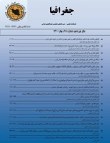Explaining the rural livability in Metropolitan area of Tehran
Explaining the rural livability in Metropolitan area of Tehran K. Zangisheh, A. Estelaji, N. Fallah Tabar The issues related to the viability of perimetric metropolitan villages are not explained by the concept of rural viability and are affected by the communication network and the rural-urban associations of the cities under their control. The current topic of research is to make the viability of the villages of the metropolitan areas of Tehran (study item: Varamin city) clear. The research method is exploring-explaining, and attempts to explain the role of effective factors and forces in the viability of the perimetric metropolitan villages in the form of interior and exterior/further rural factors. In this regard, at first a review of theories, models, theoretical approaches, earlier studies, and comprehensible-analytical model has been presented. The support theory in the concept of rural viability, was the sustainable development theory, and due to that, the social, economic, viable, somatic, and its variant dimensions were primarily identified as rural interior and exterior factors via extension and Delphi identification. Nineteen variants were identified in the form of quadratic dimensions for the effective exterior/further rural effective factors in rural viability situation, as well as sixteen variants and seventeen components for the interior factors of viability of perimetric metropolitan villages of Tehran. The scrutinizing and exploration of the mentioned factors from analysis, exploited an exploratory factor, and the result was the confirmation of nineteen further rural factors and eighty one interior rural variant factors. The statistical population of the study was inhabited by villagers around the city of Varamin and Javadabad (two urban locations of Varamin) which was 53,255 people, and the cities mentioned as well as 140 people, who were professionals, experts, and local managers. In sampling of the residents, random cluster sampling was used, and the sample population of 689 individuals was determined by the Cochran formula, with 0. 05% error correction; and was distributed as share-layer among the centers. The statistical techniques used in this study were t viability of perimetric metropolitan villages T-Test (for assessing the viability) and checking the numeral values obtained by Mercer classification; Kolmogorov Smirnov Test (K. S) to determine the distribution type of the statistical population, Pearson Test to determine the viability relation of the surrounding villages and cities, were structural equations. In statistical data analysis and data spatial representation, SPSS, Lisrel, and Arc GIS softwares were used. The results of the research showed that in the metropolitan area of Tehran .
- حق عضویت دریافتی صرف حمایت از نشریات عضو و نگهداری، تکمیل و توسعه مگیران میشود.
- پرداخت حق اشتراک و دانلود مقالات اجازه بازنشر آن در سایر رسانههای چاپی و دیجیتال را به کاربر نمیدهد.


